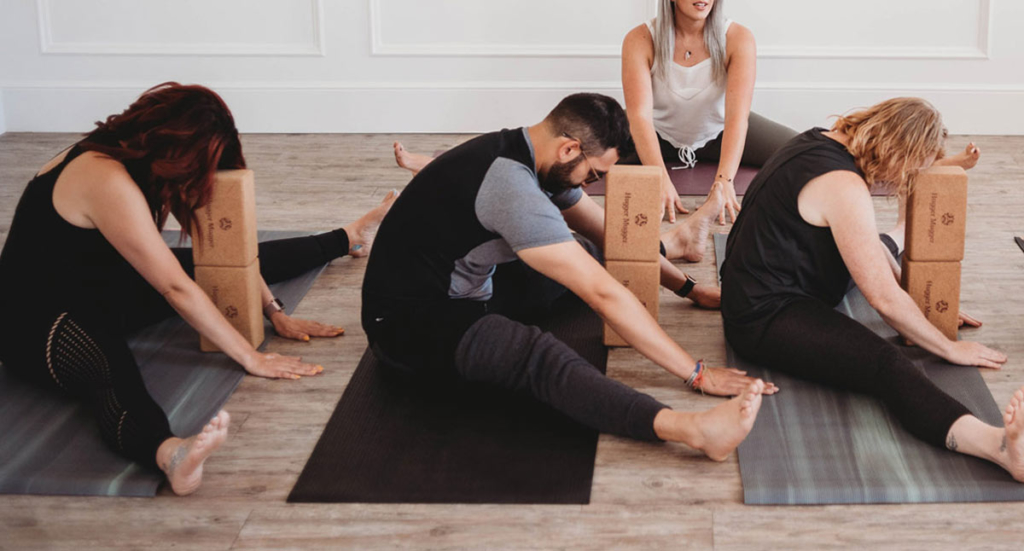
For many years, the local community put together an annual yoga fundraising event. Teachers from many of the various studios and styles team-taught a class to more than 100 students on a Saturday morning. In one of the later years of the fundraiser, organizers assigned me seven minutes to teach inversions and backbends. Mine would be the last active asana segment before Savasana. My first thought was no way, for many reasons that I’ll explain. But my initial objection was that it was not a helpful way to sequence your yoga class for a relaxing Savasana (Relaxation Pose).
The idea of teaching inversions to more than 100 students, most of whom I didn’t know, scared me. I envisioned people toppling all over the packed venue, and bringing down their neighbors along with them. So Headstand (Sirsasana), Forearm Stand (Pinca Mayurasana) or Handstand (Adho Mukha Vrksasana) were all out. That left Shoulderstand (Sarvangasana). There’s no way I’d teach that without at least three yoga blankets to support each person.
Then there was the issue of backbends. I love backbends, and there are quite a few backbends that might be appropriate for a huge class. But they are quite possibly the last class of poses you’d want to teach right before Savasana. Backbends can be incredibly stimulating, even agitating. If you want to sequence your yoga class for a relaxing Savasana, forward bends are a much better choice. I emailed the organizers with my concerns and they welcomed the input and allowed me to switch to forward bends.
Why Sequence Your Yoga Class for Savasana?
Why would you want to sequence your yoga class for Savasana? Simply put, Savasana is yoga’s most important pose. It’s the pose that separates yoga asana from other forms of physical practice. In what other practice are you encouraged to lie down and do nothing after your workout?
Years ago, my mother and my aunt took a yoga class at a senior center. When I asked them what their favorite pose was, both answered “The Sponge.” The Sponge was their name for Savasana. At first I thought the name was rather silly. But as I thought about it, I realized that it’s actually an appropriate descriptor.
In Savasana we integrate—or “soak in”—the benefits of our practice, in the same way a sponge soaks in water. We spend our practice stretching and contracting our soft tissue. Then we lie down in a receptive, supported posture and allow our bodies and minds to settle. When we don’t practice Savasana, our practice can leave us agitated and edgy. Savasana gives us time to be present with the ever-changing landscape of our bodies and minds. We emerge with a quiet energy that can carry us through our day with equanimity.
How to Sequence for Savasana
Of course, there are lots of ways to sequence a yoga class, depending on what type of yoga you’re practicing or teaching. But in my classes, I like to practice with Savasana in mind. This doesn’t mean I teach just Restorative Yoga. In fact, just this morning we practiced core strengthening for the first 30 minutes of class. In one class last week, we spent 45 minutes in standing poses. But in a 90-minute class, I always leave at least the last 15 to 20 minutes of active asana for poses that calm the nervous system.
So if I’m teaching a class that works up to backbends, for example, I want to make sure that I’ve finished the most intensive backbends about 20 minutes before our 15-minute Savasana. After the last backbend, I’ll offer a few gentle supine twists. Then we’ll practice Supta Ardha Padmasana (Supine Half Lotus Pose), so that our spines can stay in a neutral position as we begin to introduce forward bending. From there, we practice a few relaxed, often supported, seated forward bends. These help to stretch the back body, but more importantly, to quiet the nervous system.
Here are a few tips for teaching a class with Savasana in mind. Of course, feel free to explore and improvise:
- Practice heating/energizing poses for the first half of your practice. These include standing poses; inversions such as Headstand, Handstand and Forearm Stand; core strengtheners; and backbends.
- Leave time for cooling/relaxing poses in the last half of your practice. These include seated and supine twists; Shoulderstand (but it’s only relaxing if it’s an easy pose for you; struggle will create agitation); and forward bends.
- Check your intentions. Can you practice asana with a relaxed, curious intention rather than from a place of striving and pushing? Even the most relaxing Restorative Pose will be agitating if you’re worried about your “performance.” Relax. Yoga is a practice, not a performance.
The Karma of Practice
My teacher, Pujari, says that Savasana is when we collect the karma of our practice. In Savasana, we integrate the effects of our practice. When we practice with an aggressive attitude, in the poses we choose and in the way we approach them, our Savasana may well feel agitated. When we practice from a place of ease and curiosity, and when we look toward Savasana when we sequence our practice, we’ll more easily sink into a spacious calm. Explore how you might practice yoga with Savasana in mind.
